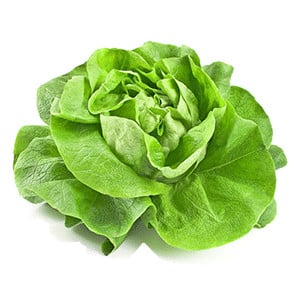Lettuce (Lettuce)

Lettuce (Lettuce)
Lactuca sativa var. crispa
Plant family
Daisy family (Asteraceae)
Cultivation Break
3 Years
Season Overview
Propagating
Planting
Harvest
J
F
M
A
M
J
J
A
S
O
N
D
Details
Light requirement
Semi-shaded
Water requirement
Moist
Soil
Light (sandy)
Nutrient requirement
Medium
Light germinator
Germination temperature
15 - 20 °C (Degrees Celsius)
Plant distance
25 cm
Row spacing
25 cm
Seeding depth
0Not specified
Instructions
The season for this plant is over. The following instructions are for the next season.
Mid of February
Propagating
Mid of February
Transplanting
End of February
Harden
Description
Lettuce is an umbrella term for many leafy vegetables. Head lettuces - as the name suggests - form a head and are harvested in one piece. Picking lettuce can be harvested continuously by picking off individual leaves at a time.
Origin:
Garden lettuces are cultivated lettuce plants (Lactuca sativa) with origins in Southern Europe, North Africa and India. They include lettuce (Batavia, iceberg lettuce), cut/pluck lettuce (Lollo Rosso/Bionda, oak leaf) and romaine lettuce.
Growing tips
Lettuces are very suitable as 'gap fillers'. They require sufficient moisture and have comparatively low nutrient requirements. With a clever selection, lettuces can be grown all year round: in spring and early summer head lettuces and cut/pluck lettuces; in summer and autumn chicory lettuces and iceberg lettuces as well as lamb's lettuce (especially in autumn, winter). For a continuous harvest, it is best to sow or plant at intervals. Species and varieties must be adapted to the season, e.g. spring varieties start to shoot when it is too hot. In this case, a long stalk is formed and the leaves become bitter. After a few weeks, small flowers appear at the top, from which many crescent-shaped seeds are formed. These can be collected for the following year or spread themselves around the bed if you leave them.
Companion Plants
Artichoke
Arugula / Rocket
Asparagus
Aubergine / Eggplant
Bean (Dwarf bean)
Bean (Runner bean)
Beetroot
Black salsify
Borage
Broccoli
Brussels sprouts
Cabbage (Cabbage)
Cabbage (Savoy cabbage)
Caraway / Meridian fennel / Persian cumin
Carrots
Cauliflower
Chervil
Chickpea
Collard greens (Kale)
Collard greens (Tuscan kale / Dinosaur kale / Palm tree kale)
Common marigold
Coriander / Cilantro
Cucumber / Gherkin
Dill
Fennel
Florence fennel / Finocchio
Kohlrabi / German turnip / Turnip cabbage
Leeks
Miner's lettuce / Indian lettuce / Winter purslane
Mint
Napa cabbage / Chinese cabbage
Onion
Onion (Spring onion)
Oregano
Pak Choi
Pea
Physalis
Radishes
Rhubarb
Rutabaga / Swedish turnip
Savory
Soybean
Spinach (Summer)
Tarragon
Turnip
Turnip-rooted chervil
Antagonistic Plants
Diseases
Downy mildew
Pests
Aphids
Flea beetles
Land snails